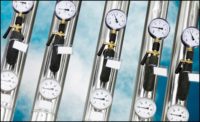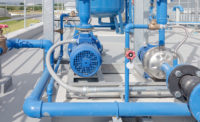The history of balancing goes back to the 1940s, when the need to adjust flow distribution in heating systems was realized to achieve the desired indoor temperature in a building. Oversizing components during design and construction cannot be avoided due to the available commercial range of products. Thus, based on the availability of the commercial products that are used for a given load range, it's important to perform hydronic balancing to obtain the required flows in the actual installation and compensate for oversizing.

In 1957, Tour & Andersson AB Sweden (currently IMI TA) invented its first balancing valve to replace low-tech equipment used to adjust flow in systems. The idea behind an adjustable balancing valve in series with each proportional control valve was, and still is, to make the sum of Cv values (commonly known as flow coefficient, which is flow capacity in gpm for 1 psi pressure drop) adjustable so they can, together, adapt to the piping system. With this combination, engineers and installers can calculate and/or adjust the setting of the balancing valve to let all terminal units achieve a flow rate matching the load needed in design conditions. With this method, it’s possible to guarantee that all terminal units will get the design flow rate regardless of their position in the piping network and building. The flow rate can be adjusted to prevent overflows that could result in high pumping costs or underflow, resulting in poor indoor climate and discomfort.
Proportional Control Valves-Sizing and Overflow
Today’s advanced control technology means, in theory, hydronic balancing is easily achievable. But, even the introduction of proportional control valves operated by advanced controllers has struggled to practically “fix” the concern of obtaining the right flow distribution. Let’s look at a scenario where a system is only equipped with proportional control valves and no balancing on each terminal unit.
As the heating or cooling needs are changing in the system, the control system should be able to detect changes in the room temperature and dynamically readapt to the new need. Most control valves move at a relatively faster speed of a few minutes, but the room temperature change is relatively slow. Due to this, the controller will drive the oversized control valve to a fully open position way before the room temperature will reach the set point. This results in an overflow situation in the valves, and the room temperature set point is quickly passed. Then, the controller will instruct the valve to close again. Based on the ever-changing needs of the system, the overflowing proportional control valve cannot accurately reach the set point and turns into on-off control. Overflow can also generate noise across the valves.

On the other hand, overflow in a coil will result in a drop in the delta T (difference between the inlet and outlet water temperature to the coil). This is due to the lack of enough heat transfer in the coil due to the higher velocity of water than expected. With a drop in the delta T, the running cost of chillers and boilers will start to increase due to the direct impact on their efficiency of up to 15%.

In addition to that, control valves are available in relatively large steps of Cv values following the Reynard series. There is typically a 60% increase in Cv from one to the next. Hence, anytime the exact same Cv for the circuit is not found, which is the majority of the case, control valves get 30%-50% oversized. The HVAC business still uses a lot of traditional control valves with fixed Cv values for proportional control on all terminal units, heat exchangers, production units, etc. The use of this type of control valve with fixed Cv in millions around the world bolsters the need for manual balancing on small to large terminal units.
Reverse Return Systems
In the engineering industry, reverse return piping systems theoretically eliminate the need for balancing. Reverse return piping (often termed as self-balancing) architecture was invented by Albert Tichelmann (1861–1926). The problem with the oversized control valve explained before is not at all eliminated with a reverse return design. The reverse return system uses the idea of using the pipe pressure drops to equalize the available differential pressure to each terminal unit. In a rather uniform network design with the same flow rates, it’s somewhat achievable but not completely. If variable flow rates are needed, one needs to add balancing solutions to reverse return piping as well.

A hydronic balancing procedure is required in order to ensure the correct flow rates and pump optimization in the system for obtaining the desired comfort and pump energy savings of up to 35%. A drawback of reversed return is that no methodical balancing methods can be used in such a system. This is due to the inability to use the established proportional rule for balancing in a reverse return system.
Reducing the need for balancing by oversizing distribution pipes in reverse return piping will, by nature, reduce the level of pressure drop into manual balancing. However, it’s still not making manual balancing indispensable due to the oversizing of the control valves. Oversizing the piping is done in some areas of the world, like Scandinavia, Switzerland, etc., where pipe sizing is done with a maximum pipe pressure drop of 1 foot per 100 feet. Balancing is still required in those systems, and, thus, it does not eliminate the need for it.
Systems with High Pump Heads and Pressure Drop
When proportional control valves are placed in systems with high levels of pressure drop in the piping network and/or high final pump head, manual balancing might not be the optimum solution as a balancing partner for proportional control valves. High available pressure in the system and low-pressure drop across oversized control valves result in a low control valve authority, which determines how well a control valve can get to a set point despite the pressure fluctuations.

ASHRAE has defined acceptable control valve authority at 0.5 or higher for excellent control at design conditions, and a minimum authority of 0.25 or higher to ensure good control at partial load when all other control valves in the system are closed. Proportional control valves with control valve authority below 0.25 will be unstable and thus work as on-off controls.

In such a case, it's advantageous to utilize differential control to decouple the control valves away from the high-pressure drop components, like the main distribution piping.
Thus, a solution to all the issues that are highlighted above would be to provide a control valve solution with the ability to adjust the Cv value without affecting the equal percentage modified (EQM) characteristics and increase the control valve authority at the same time.
Differential Pressure Controllers
One of the solutions to achieve better control valve authority is to use a pressure-independent balancing and control valve (PIBCV) on each terminal unit, which eliminates the need for any balancing valve and maintains the control authority of more than 0.7. However, for a building with hundreds of terminal units, this could be very expensive. Thus, designers typically use PIBCVs for main cooling and heating coils at the air-handling units.
Differential pressure controllers could be a better alternate in larger systems for terminal units. These controllers essentially control the available pressure at each of the control valves within the branches they're located, thereby increasing the control valve authority. Differential control can be performed by placing stand-alone differential pressure controllers in some strategic locations in the network. Such locations can be at the bottom of each riser or from each takeoff from the riser into each floor branch. The closer the differential pressure controller is placed to the proportional control valve the better controllability they will get.

Is Manual Balancing Enough or Is Differential Pressure Control Needed?
It’s a rather simple judgment. If the pressure drop in selected control valves represents 25% or less of the pump head by using manual balancing, then some kind of differential pressure control is recommended.
Where to Place the Differential Pressure Controller?
If the pressure drop in the selected control valves represents 25% or more of the stabilized differential pressure by placing the differential pressure controller at the beginning of each riser, the controllability will be of a satisfactory level. If not, the differential controller must be placed closer to the control valves, like at the beginning of each branch.
In some cases, it’s not even enough to place differential controllers on the branch level, in which case, PIBCV can be utilized on each individual terminal unit.
Is PIBCV with an Authority of 1.0 Available?
Quick answer, it’s not possible to create a 100% efficient controller with a self-working differential controlled valve. One must know a differential pressure controller and the differential pressure control part of a PIBCV are proportional controllers. All proportional controllers do have a working range within which they can stabilize pressure from an open to a closed differential control valve. This range is very different from product to product.
Conclusion
Is balancing still required with proportional control solutions? The answer to this is absolutely yes. However, various technologies are available, depending on the system design. Some strategic balancing design solutions for optimal balancing and control for various system designs are listed below:
- Strategy 1: Manual balancing valves, when Dp in the control valves are ≥ 25% of the pump head. This ensures minimum control valve authority will be ≥ 0.25 for good controllability. If authority can’t be achieved with this option, follow strategy 2.
- Strategy 2: A differential pressure controller is placed on the beginning of the risers and a manual balancing valve on the terminal unit or circuit setters for a group of terminal units. When the Dp in the control valves is ensured to be ≥ 25% of the stabilized pressure, the minimum control valve authority (≥ 0.25) for good controllability can be achieved. If authority can’t be achieved with this option, follow strategy 3.
- Strategy 3: A differential pressure controller is placed on the beginning of each branch and manual balancing on the terminal unit or circuit setters for a group of terminal units. When the Dp in control valves is ensured to be ≥ 25% of the stabilized pressure, the minimum control valve authority (≥ 0.25) for good controllability can be achieved.
- Use a PIBCV on all individual terminal units. This will always ensure high authority and controllability. However, this solution can be a bit more costly in both investment and running costs on the pump due to the higher starting pressure of some PIBCV valves.
Overall, the balancing of a hydronic system is important. It helps detect errors made in the piping network, like clogging, valves installed backward, etc. It's always cheaper to identify such issues in the early phases, before the building is occupied, to avoid additional costs and discomfort. In some critical cases, like hospitals or data centers, issues identified down the road may result in a system shutdown, which can cause much bigger concerns. Hence, balancing is not a cost but, rather, an investment in getting good controllability in proportional control valves leading to a high level of indoor comfort and energy efficiency.






